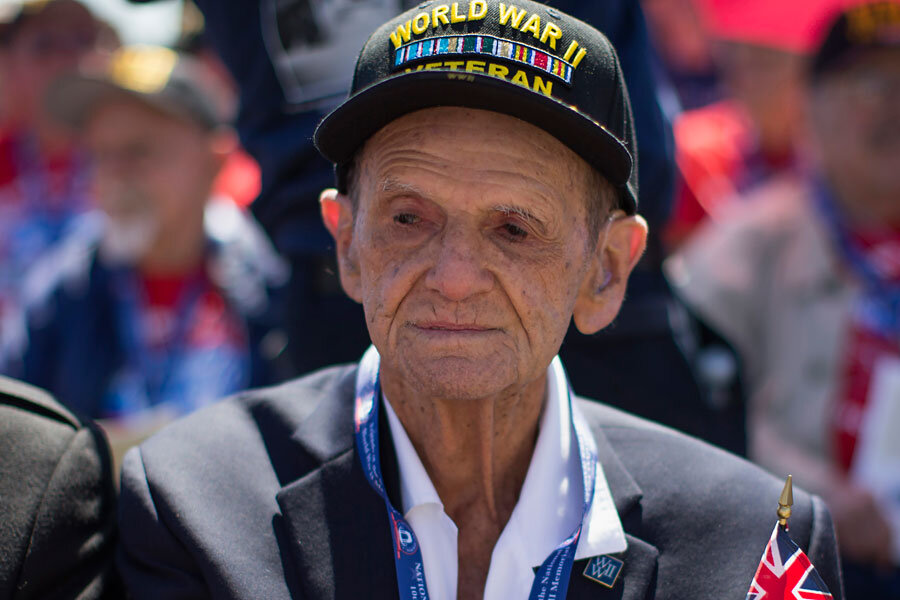D-Day remembered: why Allies finally won Normandy campaign
Loading...
| Washington
D-Day was the beginning of the end for Nazi Germany. At the close of June 6, 1944, the Allied high command had high confidence its troops could hold their beachhead along France’s Normandy coast. From there, the Allies’ material and manpower superiority – and the grinding of the Red Army on the Eastern Front – meant eventual victory was glimmering on the horizon.
But the way was hard, and not just to Berlin. To many Americans today, “D-Day” may be almost synonymous with the battle for the region of Atlantic France upon which the invasion force landed. But as night fell on June 6, British forces were still far from one of their primary objectives of the city of Caen. Americans had faced a ferocious German defense on Omaha Beach and had yet to push far enough inland to protect the men and supplies pouring onto the sand from incoming artillery.
Today the US Army Center of Military History counts the battle for Normandy as lasting until July 24 – over six weeks. Initial Allied bridgeheads were not connected until June 12.
Allied commanders had expected their German counterparts to bend if the initial landings were not repulsed, and withdraw some miles to regroup and concentrate for a large counterattack. Instead, the Germans opted for a forward defense in which they contested virtually every mile of ground. By June 17 German commanders were asking their Fuehrer for permission to withdraw their armored forces out of range of Allied naval guns so they could launch an armored attack on the British flank. Hitler denied the request.
“He forbade his commanders to abandon any position voluntarily and ordered them to hold their ground at all costs,” according to the Army Center for Military History.
The ensuing ground campaign was terribly deadly for both sides. US units with little combat experience inched through Normandy’s countryside yard by yard, slowly digging out more seasoned German troops.
“The Americans fought a series of hard battles to secure the Cherbourg Peninsula, where the small fields, steep banks and dense hedges of the bocage country enabled the defenders to inflict heavy losses for every small gain,” writes journalist and historian Max Hastings in his book “Inferno: The World at War, 1939-1945."
US troops finally entered their objective of the town of St. Lo on July 19.
In contrast, the land in the British and Canadian sectors was more open and lent itself to mechanized unit assaults. Paradoxically, this made the task of moving on Caen even harder. Aware of the area’s defensive weaknesses, the Germans concentrated their effective Panzer tanks and best troops in the path of Commonwealth units. Casualties on both sides were appalling.
British bombers destroyed much of Caen itself as they tried to pound its defenders into submission. The Allies captured half the city on July 9 but did not dislodge German units from the rest of the area and surrounding roads until the end of the month.
In front of all Allied armies now lay land that was dry and even more open. “The final act of the war, the great push through France into Germany itself, could now begin," according to the Army Center for Military History.
Why did the Allies win, anyway? The Germans had consistently demonstrated superior small unit tactics. It took an average of five Americans to dislodge one German in the Normandy hedgerow country, a ratio worse than the expected 3-to-1. German tanks, rifles, and artillery were in many cases better than Allied equivalents.
Sheer numerical strength was important. The Normandy landings were perhaps the greatest seaborne invasion, ever. German soldiers left many eyewitness accounts of astonishment at the vast flotilla that appeared in front of their eyes on June 6. By July 1, the Allies had landed a million men and 177,000 vehicles in France. Dedicated to forward defense, German commanders had to throw arriving units into the front lines to plug holes. They could not create an adequate reserve force for counterattack.
Command of the air was vital. Within days of D-Day, US fighters were operating from airstrips on French soil. The Luftwaffe had been virtually driven from the skies over the area. German units could reposition only at night. They found it suicidal to attempt to move armor daytime.
Allied units learned from experience. Each day they grew more skilled in the combined arms warfare necessary for modern offensives, with infantry, tanks, and airpower working together. That would serve them well in the months ahead.
And finally – and perhaps incredibly to many Americans, even to this day – Normandy and the Allied invasion were not Hitler’s most dire military problem. That was the Russians. Two-thirds of the German Army was deployed as a shield against the Red Army on the Eastern Front.
Three weeks after D-Day, Stalin launched his own attack, Operation Bagration. It was “the greatest offensive of the war," writes Max Hastings. Almost two and a half million Red Army troops threw themselves upon German divisions, which had been ordered to stand firm, as in Normandy. In two months, Soviet units advanced 450 miles. By the end of August, they were nearing East Prussia and Germany itself.






